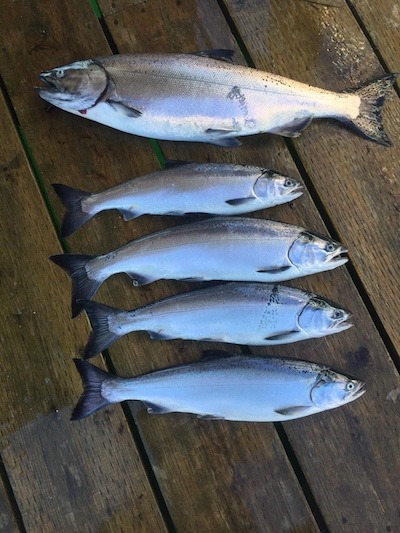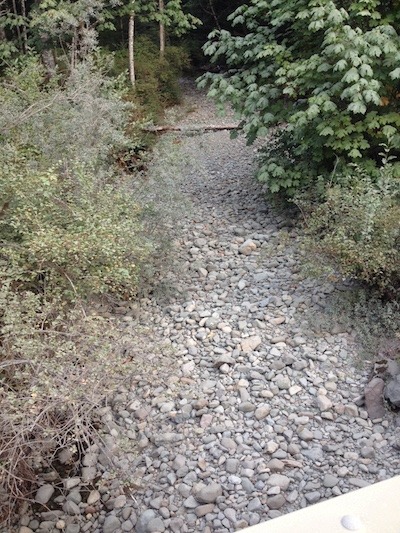
Most readers from around the Strait of Georgia will be familiar with the history of coho in the recreational fishery there. Up until the mid-1990s, coho were the foundation almost every year for productive salmon fishing in the Strait of Georgia recreational fishery. Since then, however, their presence has been much less predictable, and they often don’t show up until late summer, and even then they are much less abundant than in the past.
While there has been much to be concerned about regarding the management of the SBC inner coast recreational fishery in 2018, one clear positive has been the presence of coho this early summer, often in good numbers. To date most coho have been encountered by anglers while fishing for Chinook salmon, but as the season progresses this will likely change as the fish settle into shallower water locations and anglers adjust their gear and tactics to take advantage of the first sustained coho opportunity around the Strait of Georgia in some years.
Many anglers will be wondering why this welcome turn of events is happening this year as opposed to others. The truth is that no one knows for sure, other than to say that the right combination of environmental factors—water temperature and salinity, as well as sufficient food of appropriate types—persuaded the coho grilse to over-winter on the inside instead of migrating out to the west coast of Vancouver Island (WCVI) last fall. Young coho—bluebacks, to use the old coastal name—were reported in the French Creek to Schooner Cove area by late 2017, and they pretty much stayed there all winter and spring. For example, I never encountered any, nor have I heard any reports from those who did, in the Campbell River winter Chinook fishery, but I heard numerous reports of bluebacks in almost nuisance numbers, attacking lures intended for Chinook along the central east coast shoreline during the first five months of this year.
In early June the coho decided to spread out, reaching my home area around the very top of the Strait of Georgia by the middle of the month. Likely this dispersal had to do with food availability, as the coho will start to grow quickly now that they are of a size to start eating larger herring. This isn’t to say they won’t continue to eat much smaller prey such as euphausiid shrimp (krill) whenever they can, which—judging from the dark red-brown feces excreted by many of the coho I’ve boated this year—is fairly often. They also will hammer young herring of the year, now an inch or so long, and these will be a dietary staple for the coho all summer.
Once again in 2018, retention opportunity around the Strait of Georgia is restricted only to hatchery origin coho, those identified with a missing adipose fin. Encouragingly, the ratio of marked (fin-clipped) to unmarked fish is fairly high, providing a meaningful retention opportunity; pictured is an early July catch near Campbell River.  Those with an adipose fin are deemed to be wild fish and at the present time must be released. Ideally, the presence or absence of an adipose fin should be determined while the coho is still in the water, with wild fish released without ever bringing them in the boat. If the amount of handling can be minimized, especially not using a landing net that can cause a loss of scales and protective coating, the chances of their survival are much increased.
Those with an adipose fin are deemed to be wild fish and at the present time must be released. Ideally, the presence or absence of an adipose fin should be determined while the coho is still in the water, with wild fish released without ever bringing them in the boat. If the amount of handling can be minimized, especially not using a landing net that can cause a loss of scales and protective coating, the chances of their survival are much increased.
And we do want them to survive because, despite the current abundance, coho around the southern part of their range are a salmon species with many challenges and are a long way from the sustained population level that existed before the 1990s. Ever since non-retention of wild coho came into effect in 1998, their abundances between years have gone up and down even in the absence of directed fishing, demonstrating that it’s environmental factors rather than harvest which are causing these large variations.
Because regardless of which party is in power, the federal government so pitifully underfunds DFO that the resources available for coho stock assessment border on the criminally negligent. One outcome of this is that in recent decades the department has adopted the simple strategy of managing wild coho in fisheries around southern BC as measured against one stock aggregate—the coho originating from upstream of the Hell’s Gate Canyon, otherwise referred to as Interior Fraser (IFR). This vast area, including the Thompson and other large tributary rivers to the Fraser, has for several reasons had more coho stock assessment effort directed to it than the lower Fraser or Vancouver Island areas, and based on the scant information, we can assume that the health of these other stock aggregates for the most part tracks that of IFR coho.
The ongoing management objective for IFR coho is to keep the exploitation rate (ER) exerted by all fisheries within a range of 3% to 5%. Given that there’s almost no enhancement of IFR coho, and that wild fish can’t be retained anywhere in the ocean they are thought to be prevalent, this amounts to an allowance for any mortality on released fish in order to permit fisheries for other salmon species to proceed, and in which wild coho are an unavoidable by-catch. Compare that exploitation rate to the 70-80% rate which was routine pre-1990s when directed fisheries on wild coho existed. Yet twenty years on, or nearly seven complete coho generations, these fish have failed to rebuild in any sustained way.
One characteristic of coho is that they will inhabit even the smallest of creeks, and in larger watersheds will frequently migrate well up into the headwaters before spawning. Another characteristic of coho is that they have a fairlyextended freshwater life history, having to survive through the summer following their birth the previous fall. The trend of increasingly dry and hot summers is proving to be a real threat to coho survival in southern BC long before they ever get to the ocean, as water temperatures soar and volumes diminish simultaneously.

Pictured is a Campbell River area creek in late August 2016—how is a coho fry supposed to survive in that environment?
In any event, the abundance of coho in the Strait of Georgia this summer is a welcome surprise, at odds with most recent seasons, so enjoy the opportunity while you can. Fish with lighter gear to maximize the sporting value of these wonderful fish, and attempt to release every wild coho in the best condition possible. A summer season like this one in the Strait of Georgia with productive Chinook and coho fishing is a reminder of the past and gives me hope for the future!
Visit the Store
$34.99
$34.99
Featured Catch

Joel Unickow halibut (Photo: Rob Frawley Lucky Strike Sportfishing Tofino)







